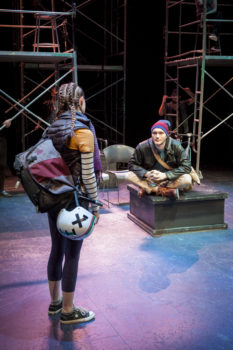
Photo courtesy Carl Lindberg
In “Ghost Bike,” the underworld came to life; but it was reinvented, Chicago-style.
This contemporary production was visibly influenced by Chicago bike culture as well as ancient mythologies.
The play largely follows Ora after her best friend Eddie is hit by a car while riding his bicycle. Just before the fatal accident, the friends argue over Ora deciding to leave Chicago for college.
Ora then isolates herself from friends and family and succumbs to the first stage of grief: denial. The play incorporates flashbacks, which not only illustrate Ora and Eddie’s friendship, but also her longing to feel like Eddie is still with her.
Begrudgingly, she visits a counselor and meets the charismatic Satyr, who is later discovered to be Yama, the king of the Underworld, in disguise.
Although Ora is uninterested in his flirtatious advances, she perks up when tempted with the possibility of getting Eddie back. Yama confidently reminds her, “Death is just a state of being. If you want to bring somebody back, you just bring ‘em back!” His prodding commences Ora’s bewildering journey into the Underworld.
I felt the introduction of more set design to “Ghost Bike” in comparison to past plays helped immerse viewers into each scene. There were three sections of risers for the audience and each of them were lined with chain-link fencing and black tarp, which gave the room an industrial feel, fitting to both the streets of Chicago and the Underworld.
The inclusion of bikes also helped me feel more included as a viewer. Even though it wasn’t an interactive play, the almost constant motion kept me at attention, expecting the unexpected.
The large pieces of bare metal scaffolding, the highest one standing more than 10 feet tall was a mere few feet from the Black Box’s ceiling, were instrumental to “Ghost Bike’s” set design. These pieces proved that set design doesn’t have to be elaborate to be effective.
In addition to maintaining the play’s industrial atmosphere, their constant presence also meant they were utilized in multiple ways. The lofty height took the set design to another level, serving as an anchor during scenes where fake snow rained down and lights dangled from the tallest platform.
I also enjoyed seeing the cast creatively interact with the pieces, like when Eddie watches scenes of his loved one’s daily lives on Earth like TV, and each scene is framed by the scaffolding. But sometimes, it was just as simple as members of the ensemble leaning on the scaffolding and looking on from the background like spirits.
In contrast to these more raw elements of the set design, multi-colored spotlights and original sound design (my favorite set elements) added drama, emotion and authenticity to DMACC’s first co-production.
Upon entering the Black Box, the audience found a space with only enough light to navigate to their seats, as well as pitch-black areas of the theater that were designated for the entry of cast members.
However, this quickly changed once the play began. Red, white, and blue spotlights emphasized different emotions and were tailored to different settings. Ora delivered several soliloquies to Eddie during the performance, and the red spotlight highlighted her frustration in those moments.
I think the sound effects may have been the play’s most effective asset. The mimicking of Eddie’s car crash after he fights with Ora and rides away was particularly memorable; It felt like it happened right there in the theatre. There were some very emotional moments in “Ghost Bike” and the new set design enhanced the drama of them.
Amid the more tense scenes, the audience (and I) enjoyed several moments of comic relief. Ora meets with the uppity counselor who prods her and deems her responses “red flags,” while also conveniently whipping out physical red flags. The interaction ends with the counselor receiving a deserved slap to the face. An honorable mention is also certainly due to the actor who played the “map.” He guided Ora through the Underworld but communicated solely through a vocal sound effect.
At the heart of the play was clearly a message regarding grief. In fact, Ora’s character embodied the stages of grief; especially denial, anger, and bargaining. Ora doesn’t want to accept Eddie’s death, so she falls for King Yama’s wild goose chase that will supposedly bring him back. Throughout her journey she often shows anger toward Eddie and the people she encounters in the Underworld.
However, Ora’s character was fiery to begin with, and the increased hardness and hostility brought on by grief sometimes made her hard to connect with. Although her demeanor didn’t always seem to display affection for her friend, her actions did. She bargains away possessions and even offers her life to Yama in exchange for Eddie’s return to life on Earth.
Overall I thought “Ghost Bike” accurately depicted the stages of grief and their effects. Ora’s willingness to give away her belongings and herself was fruitless in the end. Eddie doesn’t want to go back and despite her fervent denial she eventually transitions to the last stage: acceptance.
The play was also well-coordinated. In a production with so many moving parts, the cast had to handle transitions between scenes and they accomplished them quickly and precisely. It was great to experience the DMACC theatre department take the big step into co-production, and I hope they only continue to grow from here.





Comments